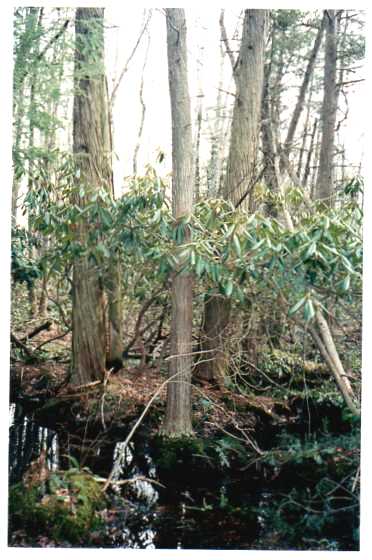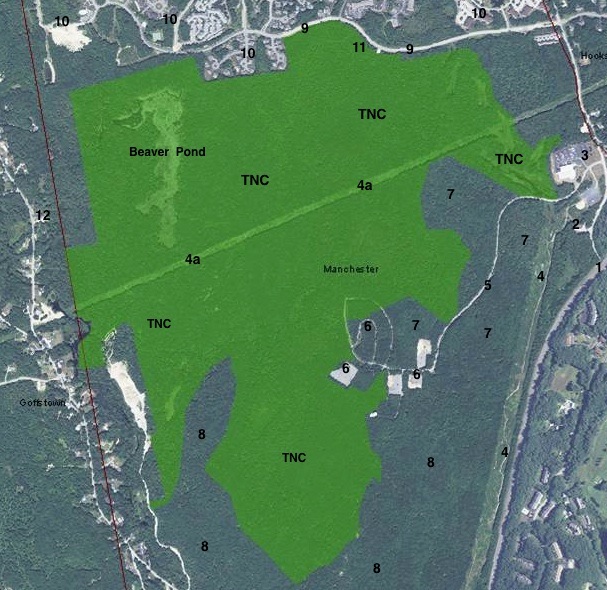|
|
|
|
|
|
AN "INDUSTRIAL PARK"PLAN FOR MANCHESTER'S HACKETT HILL AREA HAS NOT MATERIALIZED. Atlantic white cedar swamps could still be at risk!
GO DIRECTLY TO HACKETT HILL DEVELOPMENT PLANS - JUNE ,2010 - SEPT, 2012
The Hackett Hill area is located in Manchester's northwestern corner, in Ward 12 of the city. As shown on the map, it borders on Hooksett and Goffstown. A once-quiet semi-rural area - in recent years, it has seen a drastic loss of open space. Land clearly appropriate for animal habitat and animal corridors has been instead approved by City planners for large housing complexes.
Of major importance is the location of the new houses, apartment buildings and condominiums. They are/will be situated directly north and northwest of a unique, highly protected 600 acre swamp complex. It is an ecological preserve that is owned and managed by The New Hampshire Nature Conservancy and is known as The Manchester Cedar Swamp Preserve".
The Preserve contains many interesting components - the most valuable of which are Atlantic white cedars and giant rhododendrons. Yet the extensive blasting involved in this development has given no consideration to highly likely effects on swamp hydrology.
To add insult to injury, there is currently a plan to construct a large business-industrial complex on City-owned land on the opposite side of the Preserve. The construction plans are centered around remnants of a failed 1970s attempt to develop the property. (The visible components of this long-ago debacle are a set of "phantom parking lots" at a high point on the property's interior and an "access road" leading to them).
The "new"plan, which actually surfaced nearly a decade ago, calls for extensive deforestation and blasting, as well as the construction of buildings, parking lots and roads. Major components of the building complex may lie within a swamp watershed. Also completely ignored is the fact that the swamp uplands are habitat for a wide variety of large and small mammals and numerous bird species. Some regard has been paid to the presence of vernal pools in the area,(thanks to the EPA), but nevertheless the pools may not remain functional amidst the extensive construction that is planned.
Importantly, the complex will draw much additional heavy traffic to an area already overwhelmed by traffic concerns - namely Route 3A and Hackett Hill Road.
Clearly, the placement of a business-industrial park in this location demonstrates extremely poor city planning. Under an EPA mandate, the City of Manchester has spent millions of dollars to establish and protect the Preserve. Moreover the land slated for development has been used for many years for educational purposes by the NH Audubon Society and UNH Manchester. It should now become primarily protected land and serve as a "buffer" or "surrounding natural landscape" for the Preserve.
It is interesting that the single existing building at the property's periphery, originally home to UNH-Manchester, substantially enhances the entrance to the land slated for development. The building, which has been enlarged in an environmentally-conscious manner, houses a research-development company (JPSA). It's appearance suggests that a limited number of similar buildings, whose occupants are also concerned with research and development, might be permitted in this same general area, in lots not directly adjacent to the Preserve.
The major portions of the land slated for development are highly appropriate for environmental education purposes and could also furnish passive recreation opportunities for Manchester residents. These activities, together with a reasonably-sized "research park" campus, would not cause a noticeable increase in the horrendous traffic problems in the region.
Fortunately, plans for a "business park" on Hackett Hill are currently "on hold", and another threat - the possibility of the construction of a prison on the property, has come and gone. Unfortunately, city officials have chosen to approve a slew of residential housing on some of its owned lots along Hackett Hill Road - thus further contributing to the disappearing green space in the area and turning a blind eye to the incredible traffic nightmare that already exists.
Moreover it should be noted that regardless of which type of development occurs, it is only considered to be "Phase 1" of the land owned by the City that is directly adjacent to the Preserve. Additional unprotected land to the south/southwest has been designated as a "Phase 2" development area and could be equally problematic.
The only positive action that has occurred has been the construction of a new fire station during 2012 and 2013. See details of the construction on You Tube.
HACKETT HILL PRESERVE-DEVELOPMENT AREA
The GIS map below shows the location of the TNC Preserve, some of the current and planned residential development to the Preserve's north, the planned Phase 1 and Phase 2 development areas, the Manchester-Hooksett and Manchester-Goffstown borders, the location of Hackett Hill Road - the only access route leading to the above-mentioned residential and phased development-planned areas - and a number of other landmarks.
Unlabeled map courtesy of Peter Steckler, NHTNC





 Watch
Manchester Public Television
Watch
Manchester Public Television